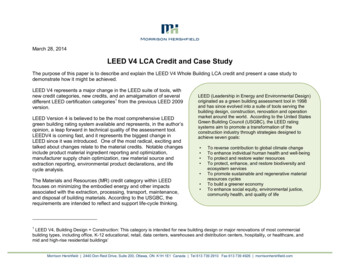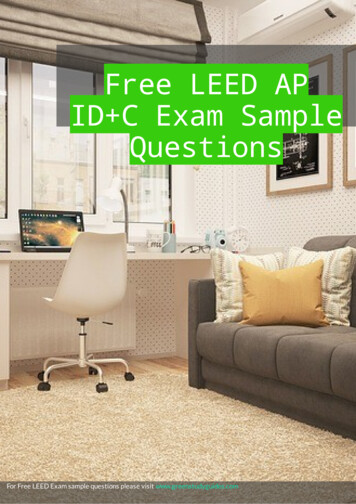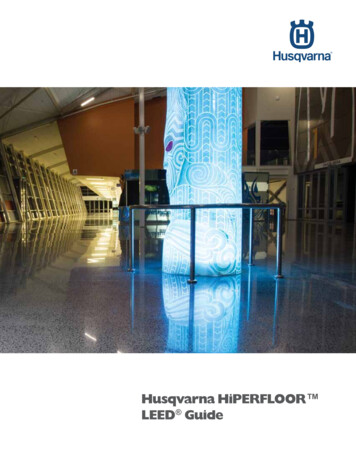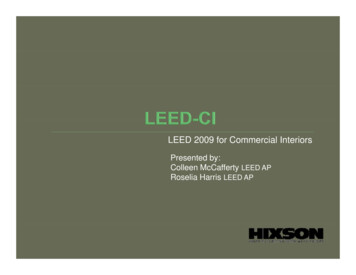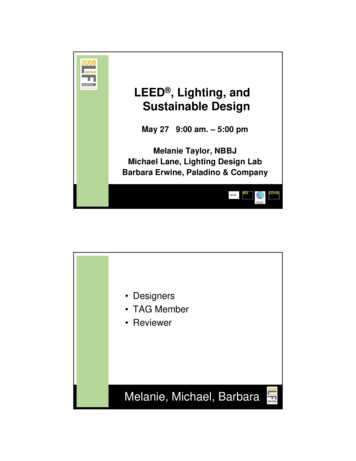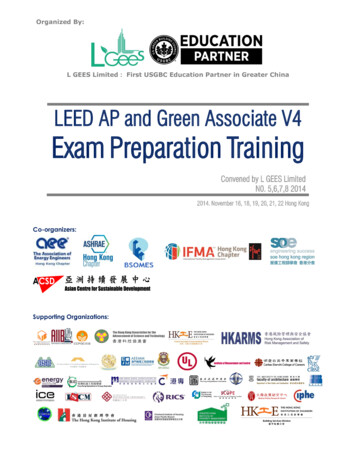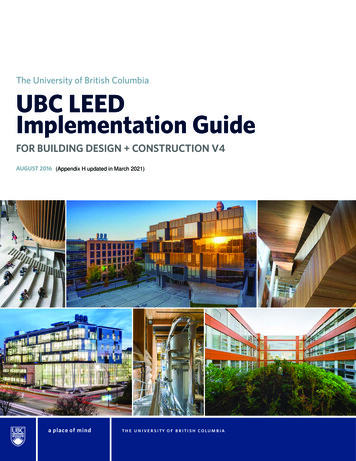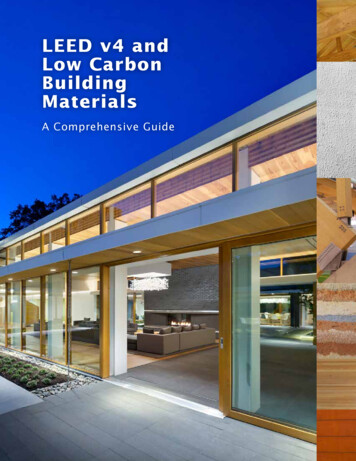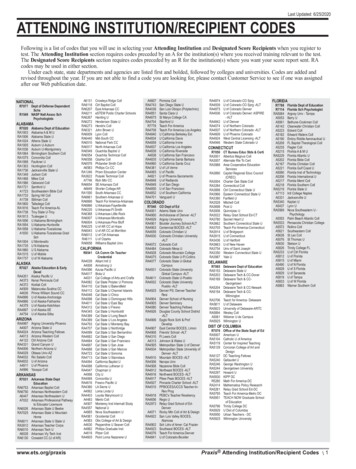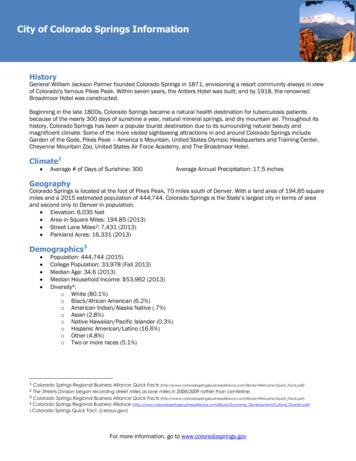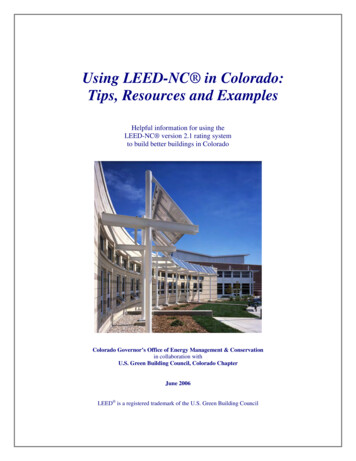
Transcription
Using LEED-NC in Colorado:Tips, Resources and ExamplesHelpful information for using theLEED-NC version 2.1 rating systemto build better buildings in ColoradoColorado Governor’s Office of Energy Management & Conservationin collaboration withU.S. Green Building Council, Colorado ChapterJune 2006LEED is a registered trademark of the U.S. Green Building Council
Funding and Project Management:Colorado Governor's Office of EnergyManagement & Conservation (OEMC)225 East 16th Avenue, Suite 650,Denver, CO 80203303-866-2100Linda Smith, LEED AP, Sr. Program ManagerEdited by Joan Gregerson, LEED AP,Consultant under contract to OEMCE-mail: rebuildco@state.co.usWebsite: www.colorado.gov/rebuildcoIn Collaboration With:U.S. Green Building Council, ColoradoChapterAmy Jiron, Executive Director303-229-9429E-mail: amy@usgbccolorado.orgWebsite: www.usgbc.org/chapters/coloradoLEED and Leadership in Energy andEnvironmental Design are registered trademarks ofthe U.S. Green Building Council (USGBC).Website: www.usgbc.org/leedWritten By:Architectural Energy Corporation2540 Frontier Avenue, Suite 201Boulder, CO 80301Website: www.archenergy.comAuthors: Amanda Portman, Caroline Clevenger and Courtney FranceAcknowledgements:Thank you to the authors, advisory committee, USGBC Colorado Chapter and project teams forcontributing to this Guide.Advisory Committee:Lauren Yarmuth and Josie Plaut, DOMANI; Peter D’Antonio, PCD Engineering Services, Inc; DougHargrave, Long & Associates; Kristi Ennis, Boulder Associates, Inc.Disclaimer:The information herein is intended to aid in the use of the LEED-NC Rating System in Colorado. Thisinformation is provided only as a guide. The information reflects the authors and reviewers experiencewith LEED projects in Colorado, plus information from project teams and is not comprehensive. Noguarantee of accuracy is implied. Refer to the USGBC for specific details of applying the LEEDRating System and to project teams for information about individual buildings. Also note that thisGuide is geared toward the LEED-NC version 2.1. This version of the LEED Rating System applies toprojects that registered before January 1, 2006. Projects registering after that date will use the LEEDNC version 2.2 Rating System. Look for updated versions of this Guide in the future.Use of this Guide:This document is intended to be used, free of charge, for all interested parties. No person or companymay sell all or parts of this document in any form without prior written permission from the ColoradoGovernor’s Office of Energy Management & Conservation. Available at www.colorado.gov/rebuildco.Cover Photo:Poudre School District’s Fossil Ridge High School is the first LEED-NC Silver certified high school inColorado. Photo courtesy: RB B Architects.
PrefaceRebuild Colorado, a program of the Governor’s Office of EnergyManagement and Conservation, offers technical assistance to help Colorado'sstate and local governments to help get better buildings through energyefficiency. Services include expertise and resources for every phase of abuilding’s life including high performance design for new buildings, energymanagement for optimizing daily operations, and assistance identifying andimplementing comprehensive energy-saving improvements in aging buildings.Visit the Rebuild Colorado website at www.colorado.gov/rebuildco to downloadthis Guide, and for case studies and additional resources.Colorado Governor’s Office of Energy Management & Conservationi
Table of Contents1. Introduction1Getting Started: USGBC & LEEDAbout this GuideLEED Certified Projects in ColoradoHistorical Data for LEED-NC Certified Projects in Colorado23362. Sustainable SitesPrerequisite 1Credit 1Credit 2Credit 3Credit 4.1Credit 4.2Credit 4.3Credit 4.4Credit 5.1Credit 5.2Credit 6.1Credit 6.2Credit 7.1Credit 7.2Credit 8Erosion & Sedimentation ControlSite SelectionDevelopment DensityBrownfield RedevelopmentAlternative Transportation: Public Transportation AccessAlternative Transportation: Bicycle Storage & Changing RoomsAlternative Transportation: Alternative Fuel VehiclesAlternative Transportation: Parking CapacityReduced Site Disturbance: Protect or Restore Open SpaceReduced Site Disturbance: Development FootprintStormwater Management: Rate & QuantityStormwater Management: TreatmentHeat Island Effect: Non-RoofHeat Island Effect: RoofLight Pollution Reduction3. Water EfficiencyCredit 1.1Credit 1.2Credit 2Credit 3Water Efficient Landscaping: 50% ReductionNo Potable Use or No IrrigationInnovative Wastewater TechnologiesWater Use Reduction4. Energy and AtmospherePrerequisite 1Prerequisite 2Prerequisite 3Credit 1Credit 2Credit 3Credit 4Credit 5Credit 6ii9Fundamental Building Systems CommissioningMinimum Energy PerformanceCFC Reduction in HVAC&R EquipmentOptimize Energy PerformanceRenewable EnergyAdditional CommissioningOzone ProtectionMeasurement & VerificationGreen 244454850515254Using LEED-NC in Colorado v2.1, June 2006
5. Materials and ResourcesPrerequisite 1Credit 1Credit 2Credit 3Credit 4Credit 5Credit 6Credit 7Storage and Collection of RecyclablesBuilding ReuseConstruction Waste ManagementResource ReuseRecycled ContentRegional MaterialsRapidly Renewable MaterialsCertified Wood6. Indoor Environmental QualityPrerequisite 1Prerequisite 2Credit 1Credit 2Credit 3.1Credit 3.2Credit 4Credit 4.1Credit 4.2Credit 4.3Credit 4.4Credit 5Credit 6.1Credit 6.2Credit 7.1Credit 7.2Credit 8.1Credit 8.2Minimum IAQ PerformanceEnvironmental Tobacco Smoke (ETS) ControlCarbon Dioxide ( CO2 ) MonitoringVentilation EffectivenessConstruction IAQ Management Plan: During ConstructionConstruction IAQ Management Plan: After Construction/Before OccupancyLow-Emitting Materials (General Overview)Low-Emitting Materials: Adhesives & SealantsLow-Emitting Materials: Paints & CoatingsLow-Emitting Materials: CarpetLow-Emitting Materials: Composite WoodIndoor Chemical & Pollutant Source ControlControllability of Systems: Perimeter SpacesControllability of Systems: Non-Perimeter SpacesThermal Comfort: Compliance with ASHRAE-55 1992Thermal Comfort: Permanent Monitoring SystemDaylight & Views: Daylight 75% of SpacesDaylight & Views: Views for 90% of Spaces7. Innovation and Design ProcessCredit 1Credit 2Innovation in DesignLEED Accredited ProfessionalAppendicesA: Credits Achieved for Colorado LEED-NC Version 2 Certified ProjectsB. Colorado LEED Certified Projects at a GlanceC: What’s New in 2.2?D: Cost and Benefits of Green BuildingE: Sources for Case StudiesF: Local Green Building & High Performance Design AssociationsG: Funding Sources for Green BuildingH: General Green Building ResourcesColorado Governor’s Office of Energy Management & iii
Chapter 1IntroductionThis Guide was developed to provide helpful information for applying the LEED-NC rating system to buildbetter buildings in Colorado. This section provides information to get you started: an introduction to theU.S. Green Building Council and the LEED rating system, an introduction to LEED Certified projects inColorado, and information about how to use this Guide.CH2M HILL Denver CampusThree LEED-NC Certified buildings: North, South & West BuildingsCourtesy: CH2M HILLColorado Governor’s Office of Energy Management & Conservation1
IntroductionGetting Started: USGBC & LEED Indoor Environmental Quality (15 possiblepoints)Innovation and Design (5 possible points)United States Green Building CouncilThe U.S. Green Building Council (USGBC) is anonprofit organization working to promotebuildings that are environmentally responsible,profitable and healthy places to live and work.The USGBC represents thousands of sustainablebuilding industry volunteers working throughcommittees to provide green building guidance,products and resources. Through this volunteereffort, the USGBC created the LEED GreenBuilding rating system as a tool to transform thebuilding market. In support of LEED and markettransformation, the USGBC offers greenbuilding educational resources throughworkshops, programs, study guides, productlistings, etc. The USGBC Colorado Chapter alsoworks towards the adoption of policies andeducational tools for sustainable buildingpractices within Colorado. For more informationon LEED and other green building resourcesplease visit the USGBC website atwww.usgbc.org and the Colorado Chapterwebsite at www.usgbc.org/Chapters/colorado. LEED: Leadership in Energy andEnvironmental DesignThe LEED rating system is a market driven,green building rating system designed tofacilitate the development of high performanceand environmentally responsible buildings.Costs and Benefits of LEEDResearch has shown that high performancedesign buildings provide a variety of benefitsincluding improved learning, occupant healthand satisfaction, and lower energy and watercosts. Refer to Appendix D for information andlinks to many examples of this research.USGBC now has three LEED rating systemsavailable: New Construction and MajorRenovation projects (LEED-NC) Existing Buildings (LEED-EB) Commercial Interiors (LEED-CI)Projects are awarded a certification leveldepending on the number of points achieved: Certified 26 to 32 points, Silver 33 to 38 points, Gold 39 to 51 points, or Platinum 52 or 69 points.Project teams using other LEED rating systemswill find useful information within UsingLEED-NC in Colorado, as the other LEEDrating systems are based, to some degree, onLEED-NC.Remember, It’s Not About the PointsThe LEED rating system is intended to help thedesign team consider effective energy efficientand environmentally preferable features. Ensurethat the design team is not pursuing ineffectivestrategies solely to garner additional points.Focus first on good design, rather than thepoints.How cost effective is LEED-NC in Colorado?The Governor’s Office of Energy Management& Conservation launched a targeted researcheffort in 2006 to address this question. Thisinformation will be available in late 2006, onlineat www.colorado.gov/rebuildco.Three additional rating systems are in the Pilotphase of development: Core and Shell (LEED-CS) Homes (LEED-H) Neighborhood Development (LEEDND)This Guide focuses on the LEED-NC Version2.1 rating system. This rating system allows upto 69 points for implementing strategies in sixareas: Sustainable Sites (5 possible points) Water Efficiency (5 possible points) Energy and Atmosphere (17 possible points) Materials and Resources (13 possible points)2Using LEED-NC in Colorado v2.1, June 2006
Chapter 1About this GuideUsing LEED-NC in Colorado: Tips, Resourcesand Examples provides helpful credit-by-creditguidance to applying the LEED-NC version 2.1(v2.1) rating system in Colorado, as acomplement to the official information fromUSGBC.To learn about the LEED-NC v2.1 rating system,begin by obtaining the official information aboutfrom USGBC at www.usgbc.org/leed: LEED-NC v2.1 Rating System and Errata(free download) LEED-NC v2.1 Checklist (free download) LEED-NC v2.1 Reference Guide (availablefor purchase) LEED-NC Credit Interpretation Rulings(CIRs) (available to USGBC members orregistered project teams) LEED-Online: a new feature that allowsproject teams to submit documentationonline for v2.1 now, and other ratingsystems soonUsing LEED-NC in Colorado presents thefollowing information for each credit: Brief Description of the credit, Recommendations for pursuing the credit, Helpful Hints from lessons learned, Examples from Colorado projects, and Resources including links to referencedstandards and Colorado-specificorganizations and resources, Quick Facts box with implementationrecommendation and historical data.The implementation rating shown in the QuickFacts box is one of the following: Required: Prerequisites Strongly Recommended: Easily achievablefor most Colorado projects Recommended: Achievable for someColorado projects, or Worth Considering: Rarely achievable forColorado projects, but still worthconsidering.certified under version 1 and thus is not includedin the historical data.)What’s New in 2.2?Most existing projects are registered underLEED-NC version 2.1. Yet, any new projectsregistered after December 31, 2005, will useLEED-NC version 2.2. What are the changesfrom version 2.1 to version 2.2?The USGBC reports that nearly every credit hasbeen altered in some way! Refer to the USGBCLEED-NC version 2.2 Reference Guide fordetails. For a quick overview of the changes, seeAppendix C of this Guide.Downloads, Comments, Corrections?To download a free version of this Guide,provide input to the authors or to check for futureversions of this Guide, visit the RebuildColorado website atwww.colorado.gov/rebuildco.LEED Certified Projects in ColoradoThe growing experience with LEED in Coloradoprovides a wealth of cost-effective strategies andlocally available materials. Highlights frommany of these projects are included in UsingLEED-NC in Colorado. All LEED-NC certifiedprojects in Colorado through 2005 are picturedand listed in this section. There are a total of 15LEED-NC certified projects, including the Goldcertified University of Denver Frank H.Ricketson Jr. Law Building.Refer to Appendix A of this Guide for a detailedlist of credits achieved by these projects andAppendix B for an at-a-glance list.In addition to LEED-NC projects, there are nowLEED-EB and LEED-CI projects coming onlinein Colorado. This includes Amerimar Realty’sLEED-EB Gold certified Denver Place andBoulder Associates LEED-CI Gold certifiedoffice.The Historical Data shown in the Quick Factsbox shows the percentage of projects that haveachieved this credit. The projects included in thiscalculation are the 14 Colorado projects thatwere certified under LEED-NC version 2, aslisted by USGBC in December 2005. (AspenSkiing Company’s Sundeck Restaurant wasColorado Governor’s Office of Energy Management & Conservation3
IntroductionLEED Certified Projects in Colorado (as of December 2005)LEED for New ConstructionAspen Skiing CompanySundeck RestaurantLEED-NC v1 Bronze (2000)Boulder, City ofNorth Boulder Recreation Center LEED-NC v2 Silver (2003)Boulder Community HospitalFoothills HospitalLEED-NC v2 Silver (2003)CH2M HILL - Three Certified buildingsNorth, South & West LEED-NC v2 Certified (2003- 2004)Colorado CollegeTutt Science CenterLEED-NC v2 Certified (2005)Colorado Springs UtilitiesLaboratoryColorado Department of Labor & EmploymentCDLE Office AdditionLEED-NC v2 Certified (2005)Aspen Skiing CompanySnowmass Golf Clubhouse4LEED-NC v2 Silver (2005)LEED-NC v2 Silver (2005)Using LEED-NC in Colorado v2.1, June 2006
Chapter 1LEED for New Construction (continued)Continuum Partners, LLCBelmar Building 2M3LEED-NC v2 Silver (2005)Pikes Peak Regional Development CenterRegional Building Department LEED-NC v2 Silver (2005)Poudre School DistrictFossil Ridge High SchoolLEED-NC v2 Silver (2005)Opus Northwest ConstructionU.S. Dept. of TransportationUniversity of DenverRicketson Law BuildingLEED-NC v2 Gold (2005)LEED-NC v2 Silver (2004)LEED for Commercial InteriorsLEED for Existing BuildingsBoulder AssociatesBoulder Associates OfficeAmerimar Realty CompanyDenver Place N/S TowersLEED-CI v2 Gold (2005)Colorado Governor’s Office of Energy Management & ConservationLEED-EB pilot (2004)5
IntroductionHistorical Data for LEED-NC Certified Colorado ProjectsThe following table presents the percent of Colorado LEED-NC version 2 certified projects that haveachieved each credit. This data includes the 14 projects certified as of December 2005. Refer to AppendixA for a list of credits achieved by project.LEED-NC Credit NameCreditLEED PointsProjectsPossibleAchieving thisCreditSustainable Sites (14 Points Possible)SSp1Erosion & Sedimentation ControlSSc1Site SelectionSSc2Urban RedevelopmentSSc3Brownfield RedevelopmentSSc4.1Alternative Transport., Public Transportation AccessSSc4.2Alternative Transport., Bicycle Storage & Changing RoomsSSc4.3Alternative Transport., Alternative Fuel Refueling StationsSSc4.4Alternative Transport., Parking CapacitySSc5.1Reduced Site Disturbance, Protect or Restore Open SpaceSSc5.2Reduced Site Disturbance, Development FootprintSSc6.1Stormwater Management, Rate or QuantitySSc6.2Stormwater Management, TreatmentSSc7.1Landscape & Ext Design to Reduce Heat Islands, Non-RoofSSc7.2Landscape & Ext Design to Reduce Heat Islands, RoofSSc8Light Pollution ReductionWater Efficiency (5 Points Possible)WEc1.1Water Efficient Landscaping, reduce by 50%WEc1.2Water Efficient Landscaping, No Potable Use or NoIrrigationWEc2Innovative Wastewater TechnologiesWEc3.1Water Use Reduction, 20% ReductionWEc3.2Water Use Reduction, 30% ReductionEnergy & Atmosphere (17 Points Possible)EAp1Fundamental Building Systems CommissioningEAp2Minimum Energy PerformanceEAp3CFC Reduction in HVAC&R EquipmentEAc1.1Optimize Energy Performance, 20% New / 10% ExistingEAc1.2Optimize Energy Performance, 30% New / 20% ExistingEAc1.3Optimize Energy Performance, 40% New / 30% ExistingEAc1.4Optimize Energy Performance, 50% New / 40% ExistingEAc1.5Optimize Energy Performance, 60% New / 50% ExistingEAc2.1Renewable Energy, 5%EAc2.2Renewable Energy, 10%EAc2.3Renewable Energy, 20%EAc3Additional CommissioningEAc4Ozone DepletionEAc5Measurement & VerificationEAc6Green 43%57%Using LEED-NC in Colorado v2.1, June 2006
Chapter 1Historical Data for LEED-NC Certified Colorado Projects (continued)LEED-NC Credit NameCreditMaterials & Resources (13 Points Possible)MRp1Storage & Collection of RecyclablesMRc1.1Building Reuse, Maintain 75% of Existing ShellMRc1.2Building Reuse, Maintain 100% of ShellMRc1.3Building Reuse, Maintain 100% Shell & 50% Non-ShellMRc2.1Construction Waste Management, Divert 50%MRc2.2Construction Waste Management, Divert 75%MRc3.1Resource Reuse, Specify 5%MRc3.2Resource Reuse, Specify 10%MRc4.1Recycled Content, Specify 25%MRc4.2Recycled Content, Specify 50%MRc5.1Local/Regional Materials, 20% Manufactured LocallyMRc5.2Local/Regional Materials, of 20% Above, 50% HarvestedLocallyMRc6Rapidly Renewable MaterialsMRc7Certified WoodIndoor Environmental Quality (15 Points Possible)EQp1Minimum IAQ PerformanceEQp2Environmental Tobacco Smoke (ETS) ControlEQc1Carbon Dioxide (CO2) MonitoringEQc2Increase Ventilation EffectivenessEQc3.1Construction IAQ Management Plan, During ConstructionEQc3.2Construction IAQ Management Plan, Before OccupancyEQc4.1Low-Emitting Materials, Adhesives & SealantsEQc4.2Low-Emitting Materials, PaintsEQc4.3Low-Emitting Materials, CarpetEQc4.4Low-Emitting Materials, Composite WoodEQc5Indoor Chemical & Pollutant Source ControlEQc6.1Controllability of Systems, PerimeterEQc6.2Controllability of Systems, Non-PerimeterEQc7.1Thermal Comfort, Comply with ASHRAE 55-1992EQc7.2Thermal Comfort, Permanent Monitoring SystemEQc8.1Daylight & Views, Daylight 75% of SpacesEQc8.2Daylight & Views, Views for 90% of SpacesInnovation & Design Process (5 Points Possible)IDc1.1Innovation in DesignIDc1.2Innovation in DesignIDc1.3Innovation in DesignIDc1.4Innovation in DesignIDc2LEED Accredited ProfessionalLEED PointsProjectsPossibleAchieving 0%79%79%57%100%Source: Compiled from USGBC website www.usgbc.org/leedColorado Governor’s Office of Energy Management & Conservation7
Introduction8Using LEED-NC in Colorado v2.1, June 2006
Chapter 2Sustainable SitesThoughtful site selection can help reduce the disruption to local plant and animal life, as well as helprestore and enhance the surrounding environment. LEED Sustainable Sites credits encourage best practicemeasures through strategies such as alternative transportation, effective site lighting design, development ofhigh-density and brownfield sites, and stormwater management. Many owners are also realizing financialbenefits from choosing and maintaining a sustainable site, from tax incentives for brownfield developmentto reduced space conditioning by choosing cool roofing materials.Frank H. Ricketson Jr. Law Building, home of the University of Denver Sturm College of Law,is the only Colorado project, to date, to receive LEED-NC Gold Certification.Courtesy: H L ArchitectureColorado Governor’s Office of Energy Management & Conservation9
Sustainable SitesSS Prerequisite 1: Erosion & Sedimentation ControlNearly all cities require erosion andsedimentation control as part of the buildingcode requirements. Control measures can includethe use of silt fences, straw bales and sedimenttraps to minimize negative effects on receivingwaters. The EPA defines a variety of “BestManagement Practices” (BMPs). These practicesare subdivided into two main categories: The exclusion of infiltrating surface water,and The exclusion of laterally migrating groundwater.Recommendations: The general contractor/construction managershould take photographs of the measuresimplemented to document achievement ofthis prerequisite. Successful Erosion Control Plans haveincluded but are not limited to the followingmeasures:- Minimize disturbance of currentvegetation.- Use of free draining gravel ontemporary roadway.- Temporary seeding to prevent soil loss.- Silt fence with straw bales.- Catch basin silt sack sediment trap.- Catch basin straw bale sediment trap.- Prompt planting of permanentvegetation upon completion.Helpful Hints: Most cities require documentation of erosioncontrol measures for permitting purposes. Ingeneral, there is no additional cost related toachieving the prerequisite, and is usuallyachieved with normal construction practice.Verify local code requirements and bestmanagement practices with the project’scivil engineer. First time users often incorrectly assume the“Erosion & Sedimentation Control Plan”requested by LEED as supportingdocumentation is a lengthy and detailednarrative. Erosion and sedimentation controldrawings and related construction detailsdepicting erosion control measures in theCivil Engineering drawings will suffice.10QUICK FACTSImplementation: Required.Colorado Department of Labor andEmploymentSilt fence minimizes construction disturbanceExample: The North Boulder Recreation Centerachieved the prerequisite by stockpiling soil,and installing silt fences and detentionponds, straw bales and stone stabilizationpads following the most stringent erosioncontrol practices between the City ofBoulder and the EPA BMPs.Resources:The Stormwater Manager’s Resource CenterFact Sheet- Erosion & Sedimentation ControlWebsite: www.stormwatercenter.net/Arapahoe County’s Grading, Erosion andSediment Control /Engineering/GESC.aspReferenced Standard: U.S. EnvironmentalProtection AgencyStorm Water Management for ConstructionActivities, Chapter 3, Document No. EPA832/R-92-005 (September ing LEED-NC in Colorado v2.1, June 2006
Chapter 2SS Credit 1: Site SelectionSite selection is based on the previous uses andcondition of the building site. Specificrequirements are outlined in the LEED RatingSystem. In general, achievement of this credit isthe responsibility of the land owner uponselection of the site.Helpful Hints: This point is a generally a “go / no-go” pointbased on site criteria. The FEMA 100-year flood plain is mostoften the preventative requirement for manyprojects. Check the FEMA website early. It is also important to verify that the site isnot located in prime farmland as defined byLEED. In cases where no data is available fromFEMA, data from the Army Corps ofEngineers is an acceptable alternative. The 100 foot setback from wetlands includesthe location of wastewater treatment systemsor other support systems (cooling towersetc.) for the building.Resources:U.S. Department of Agriculture Definition ofPrime Agricultural Land as stated in U.S. Codeof Federal RegulationsWebsite: www.gpoaccess.gov/cfr/index.html(go to “Browse and/or search the CFR”).Colorado Prime FarmlandThis resource is a map of Colorado counties withlinks to maps of Colorado farmland by /importantfarmlands/prime-farm-lands.htmlWhole Building Design GuideGuidance on using whole system approach todesign, beginning with site selection.Website:www.wbdg.org/design/site potential.phpQUICK FACTSImplementation: Strongly recommended.Historical Data: 71% of Colorado LEEDcertified projects have successfully earnedthis credit.Federal Emergency Management Agency(FEMA) 100-Year Flood DefinitionIncludes a database of flood maps; searchable byaddress or region. Go to ‘FEMA Flood MapStore’ and then click on the ‘Map Search’ tab atthe top of the Flood Map Store web page.Website: www.fema.govColorado Division of WildlifeThis website includes a Colorado listing ofendangered, threatened and wildlife species ofspecial concern, with links to specific animalhabitats.Website: wildlife.state.co.us/WildlifeSpecies/(go to “Threatened & Endangered Species”)Definition of Wetlands in the U.S. Code ofFederal Regulations:“Wetlands consist of areas that are inundated orsaturated by surface or ground water at afrequency and duration sufficient to support, andthat under normal circumstances do support, aprevalence of vegetation typically adapted forlife in saturate soil conditions.”Colorado Division of WildlifeColorado Wetlands PartnershipThis website includes general information onwetlands, wetland types in Colorado andWetlands Partnership site etlandsProgram/WetlandsHome.htmPublic ParklandVarious websites exist for locating nationalparklands, including the following from NCSULibraries.Website: www.lib.ncsu.edu/gis/index.htmlColorado Governor’s Office of Energy Management & Conservation11
Sustainable SitesSS Credit 2: Development DensityQUICK FACTSThe intent of the credit is to encourage highdensity development to preserve open space andreduce urban sprawl. This credit can be difficultto achieve outside of major cities, since theproject must be surrounded by the equivalent oftwo-story downtown development, though someexceptions have been made for smallercommunities and for university and collegebuildings. The key is to develop in an area that isalready within an urban environment.Implementation: Strongly recommended.Historical Data: 14% of Colorado LEEDcertified projects have successfully earnedthis credit.Recommendations: Obtain a copy of the site/surrounding masterplan to quickly assess whether the credit iseven potentially viable. When thesurrounding area is privately owned,information may be difficult to obtain. Localplanning departments typically have thisinformation. Aerial photographs, availableon the internet, may also be of help.Helpful Hints: Urban sites can be more expensive;however, this credit is not usually a drivingfactor for site selection. Typically, the siteeither fits the requirements or it doesn’t, andthus does not add cost to a project. For locations that already have wellestablished infrastructure, it is acceptable totake into consideration future plannedneighboring developments to determine thearea's density (per requirements of CreditInterpretation Request (CIR) for SSc2 rulingdated 12/23/2002). In order to determinecredit compliance in this situation, it isnecessary to quantify that proposed futuredensity, and document that thedevelopments meet the density goals of theurban revitalization plan. Reference the USGBC CIRs for additionalinformation. Note: Parking (structured or open) must beincluded in density calculations. Exclude roads and right-of-way areas aswell as parks and water bodies from thecalculations. See LEED Reference Guide formore information.12Colorado Department of Labor andEmploymentCourtesy: Colorado Department of Labor andEmployment This credit is relevant in City infill projectsor campus applications. The LEED CampusApplication Guide requires, “the projectcomplies with a regional or master planningeffort to redevelop an area with existinginfrastructure into a higher density area withan ultimate intended density that reflectslocal development conditions On siteswhere the contiguous property is over 15acres, the project may use the campusboundaries in lieu of a documentation circleto calculate density.” LEED-NC projects incampus settings may use this approach as analternative compliance path to achieving thecredit.Example: Colorado Department of Labor &Employment earned this credit by building a40,000 square foot addition (in place of anexisting parking structure) in downtownDenver.Using LEED-NC in Colorado v2.1, June 2006
Chapter 2Resources:Colorado Sprawl Action CenterGrowth Management Tool KitThis resource lists a comprehensive table ofcontents with links to different issues dealingwith urban development and kit/index.htmlPlanning Commissioners JournalSprawl GuideThis online Sprawl Guide is designed tofamiliarize you with key issues associated withsprawl, and direct you to some of the wealth ofinformation available on the Web. The Coloradosection includes links to the Boulder CountyComprehensive Plan, Smart Growth &Development Initiatives and examples ofcommunities using smart growth ce-co.htmlColorado Office of Smart GrowthThis office provides direct technical andfinancial assistance to local governments in theareas of land use planning and tGrowth/Google EarthGoogle Earth combines satellite imagery, mapsand the search features to provide tools thatsimplify development density calculations.Website: earth.google.comStarting a new LEED-NC project?Beginning in January 2006, projectregistering with L
committees to provide green building guidance, products and resources. Through this volunteer effort, the USGBC created the LEED Green Building rating system as a tool to transform the building market. In support of LEED and market transformation, the USGBC offers green building educationa

